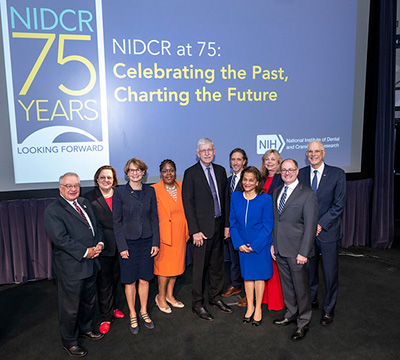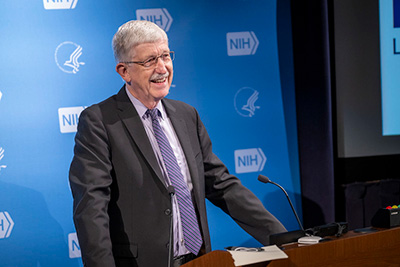NIH Leaders, Scientific Community, Federal Partners Celebrate the Past, Chart the Future
Symposium kicks off NIDCR’s 75th anniversary
NIDCR held a symposium on June 27, 2023, to kick off its year-long 75th anniversary celebration. The event featured talks from Acting NIH Director Lawrence Tabak, D.D.S., Ph.D., Former NIH Director Francis Collins, M.D., Ph.D., and University of Michigan Provost Laurie McCauley, D.D.S., Ph.D., along with presentations by NIDCR’s professional society and federal partner organizations. A video recording of the event is available through NIH’s VideoCast page.
Rampant tooth decay prevented nearly 20% of eligible recruits from serving in World War II, prompting President Harry Truman to sign a law establishing the National Institute of Dental Research (NIDR) in 1948. Since renamed the National Institute of Dental and Craniofacial Research, NIDCR stays true to its original mission, while also being a leader in the fields of pain, health disparities, microbiology, gene therapy, and regenerative medicine.
In a videotaped address, Dr. Tabak discussed the future of NIDCR within the broader context of the NIH mission. He emphasized the importance of teams that draw on researchers from a diverse range of disciplines and backgrounds, showing that research from these teams is cited by other researchers or turned into new technologies at a higher rate than the average study. He stated that “data is the new oil” and that maintaining and analyzing the vast amounts of scientific data being generated will be a vital resource in the future of health research.
Dr. Collins offered a reminder of the importance of communication to the success of the research enterprise. Highlighting the COVID-19 pandemic as an example, he noted how the challenges of the changing communications landscape meant that “in the context of one of the greatest scientific achievements, [the development of the COVID vaccine],… public confidence in science has actually dropped.” He urged researchers to place more emphasis on communications. “We don’t want to go and hide in the lab as a result of this. We must be winsome, thoughtful, good listeners, but also willing to put out there the actual facts based on rigorous science.”
Dr. McCauley hailed the importance of basic science research, which can seem “a bit far away from clinical work but so essential and critical.” She hailed worldwide research into the role of inflammation in overall health, which is “so much built on work done through NIDCR.” She also showcased NIDCR’s work in understanding the oral microbiome and its link to systemic diseases. This research has been “a critical part of [NIDCR’s] portfolio for probably the entire 75 years, and it’s evolving.” More advanced technologies and research methods are helping to disentangle the associations between systemic conditions and oral health.
George Shepley, D.D.S., President of the American Dental Association, celebrated NIDCR’s commitment to “moving dentistry forward.” The institute’s contribution of evidence for improved treatment guidelines and its efforts to foster new generations of dental researchers and other dental professionals “keeps dentistry on the cutting edge” and builds a “vibrant ecosystem” that “ultimately improves the oral health and well-being of our nation.”
Christopher Fox, D.M.D., D.M.Sc., CEO of the American Association for Dental, Oral, and Craniofacial Research (AADOCR), highlighted the historical connections between NIDCR and AADOCR, starting with the institute’s first director, H. Trendley Dean, D.D.S., who was the president of the American Association for Dental Research before becoming NIDR director. Dr. Fox also discussed the organizations’ shared goals of fostering a more diverse and inclusive pipeline of dental, oral, and craniofacial researchers.
Rosa Chaviano-Moran, D.M.D., past President of the Hispanic Dental Association (HDA), a part of the Diverse Dental Society, celebrated NIDCR’s support of research on underrepresented populations across the United States. A report undertaken by the HDA in 2021 was the first national oral health study focused on Hispanic populations in the United States. According to Dr. Chaviano-Moran, the report’s development benefited from the “support and empowerment” provided by NIDCR.
Karen West, D.M.D., M.P.H., President and CEO of the American Dental Education Association (ADEA), emphasized the shared and complimentary aims of NIDCR and ADEA. “Not surprisingly, NIDCR and ADEA are collaborators in multiple realms,” she said. Chief among those are the organizations’ shared efforts to foster the development of “future-ready” researchers and educators.
Next, a fireside chat focused on the role of NIDCR and its federal partner agencies in improving oral health across the United States.
RADM Michael Windsor Johnson, Chief Dental Officer of the U.S. Public Health Service, highlighted his organization’s collaboration with NIDCR on the development of the 2021 report Oral Health in America: Advances and Challenges, as well as the organizations’ shared goals of expanding access to dental care to vulnerable populations. On a personal note, RADM Johnson remarked that the occasion was a “coming home” for him, because he’d completed his public health residency at NIDCR.
Casey Hannan, Director of the Division of Oral Health at the Centers for Disease Control and Prevention (CDC), noted how he was surrounded by “familiar faces” at the fireside chat, because the agency representatives all collaborate closely on the U.S. Public Health Service’s Oral Health Coordinating Committee. Beyond the committee, NIDCR and CDC have a “rich history of collaboration,” including recent efforts to develop guidance for dental care during the pandemic and gather evidence for guidance on dental amalgams.
It was another homecoming for Natalia Chalmers, D.D.S., Ph.D., Chief Dental Officer of the Centers for Medicare and Medicaid Services, as she worked at NIDCR after completing her Ph.D. Her research training at NIDCR has carried over to her approach to her current work as Chief Dental Officer, giving her an appreciation for the fact that “you cannot have good health without good oral health.”
Srinivas Nandkumar, Ph.D., Director of the Division of Dental and ENT Devices at the Food and Drug Administration (FDA), discussed the importance of FDA’s partnership with NIDCR in scientific discovery. Research plays a critical role in the development of better regulatory guidelines and in producing new technologies that eventually reach patients. Looking to the future, he stressed the importance of work done at NIDCR and FDA to make dental health care more affordable and accessible.
NIDCR Director Rena D’Souza, D.D.S., Ph.D., concluded the event by discussing NIDCR’s progress in “realizing the promises of science.” NIDCR and its collaborators face a changing world, and rapid shifts in technology make this “an unprecedented time to be a scientist.” To meet this challenge, researchers must embrace “the connectome.” Partnerships across institutes and scientific disciplines will play a vital role in integrating discoveries across many specialized fields. Sharing resources across NIH, establishing partnerships, and demonstrating the importance of oral health will increase NIDCR’s impact.
For 75 years, NIDCR’s research and discoveries have contributed to the improvement of the nation’s oral health, the development of a strong pipeline of new oral health researchers, and generation of evidence for U.S. health policy. Achievements in basic science are key to the development of new treatments in the decades to come.
Attention Editors
Reprint this article in your own publication or post to your website. NIDCR News articles are not copyrighted. Please acknowledge NIH's National Institute of Dental and Craniofacial Research as the source.
Subscribe for NIDCR Updates
Receive email updates about the latest advances in dental, oral, and craniofacial research.
December 2023





